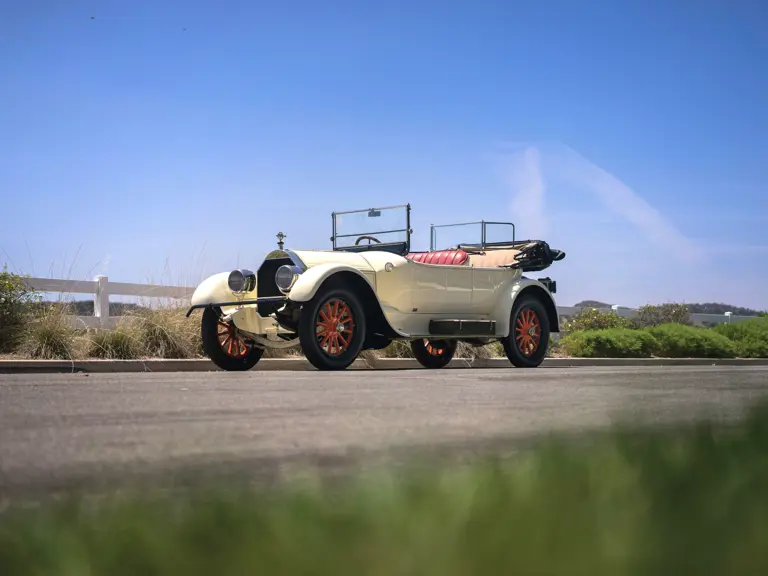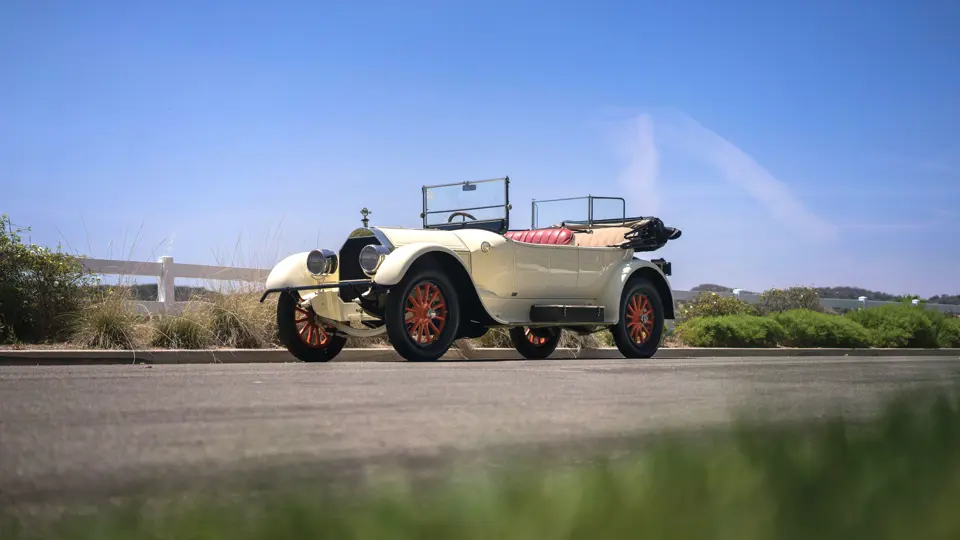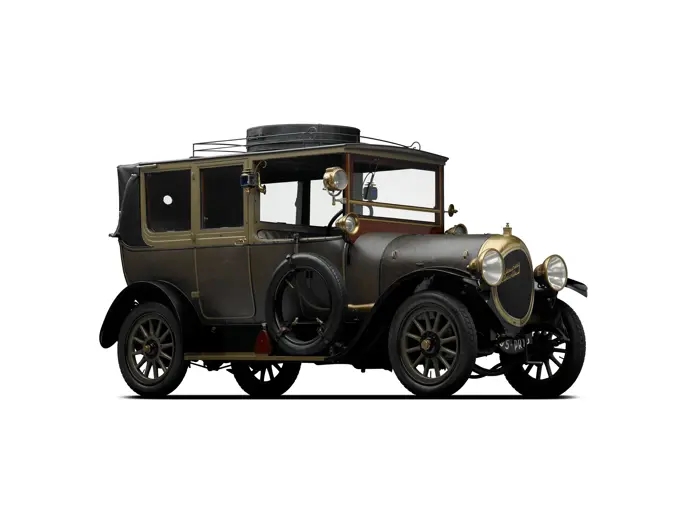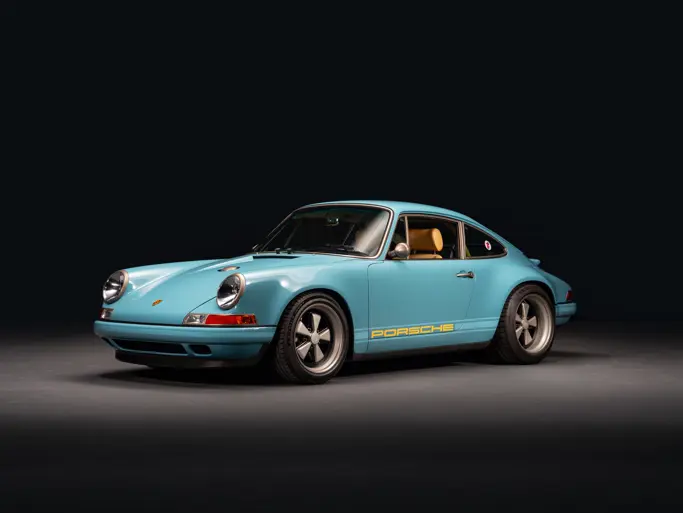The vaunted reputation of Pierce-Arrow automobiles owes no small credit to the carefully considered, step-by-step process which Pierce-Arrow, and its predecessor the George N. Pierce Company, followed in entering the automobile business.
George Pierce had been making items in Buffalo, New York since the latter years of the Civil War. Starting with housewares – which were in good demand during the country’s westward expansion following the Civil War – he started his own company, George N. Pierce Company in 1878. In addition to housewares, the company was also noted for its iceboxes and birdcages.
A few years later, Pierce’s company responded to changing economic opportunities and began building bicycles, then an exciting new product and market that was ideally suited to the Pierce company’s experienced manufacturing staff and facilities.
Bicycles sustained the Pierce company for the next half-decade, but the Buffalo entrepreneurs soon sighted its successor on the commercial horizon – the automobile. The company thereupon undertook a careful process of investigation and development, starting with steam power, then gasoline, scientifically and logically evaluating the advantages of both.
Pierce’s decision became clear in January 1901, when they hired David Fergusson to head their gasoline automobile design efforts. The first Fergusson-designed, De Dion-powered Pierce Motorettes were produced later that year. Fergusson took one on a tour of Pierce’s many bicycle dealers, an instant distribution network, which few other early automobile manufacturers could boast.
Two-seat Motorettes and four-seat Stanhopes with ever-larger single-cylinder engines soon led to the first true four-seat Pierce in early 1903, complete with two-cylinder power and shaft drive. It was called the “Arrow”. A year later, it was succeeded by a larger, more conventional looking, four-cylinder “Great Arrow”. Together, the Arrow and Great Arrows are best known for their five years of success in the Glidden Tours beginning in 1905, including four years with perfect scores.
The company’s success, however, brought the need for more capital, much of it supplied by company director George K. Birge. The growing influence of Birge and other investors created friction with George and Percy Pierce, and in 1908, they left the automobile business to concentrate on the bicycle and motorcycle company. The automobile business, acknowledging the reputation now attached to the Arrow name, was renamed the Pierce-Arrow Motor Car Company.
Of more importance, the first Pierce-Arrows included the company’s first six-cylinder engines, which were offered in 36, 48 and 60 horsepower size. In 1910, only sixes were built, setting the precedent for all subsequent Pierce-Arrows until introduction of an eight in 1929. In 1913, Herbert Dawley, who had been in charge of designing Pierce-Arrows since 1907, patented the Pierce-Arrow’s signature headlight design, which integrated the lights with the front fenders.
The Pierce-Arrow sixes had cylinders cast in pairs and secured to aluminum crankcases. Every part and piece built in the Pierce-Arrow factory was of the finest quality, and the Pierce-Arrow T-head design was considered one of the most powerful in the industry. All engines were dynamometer tested for performance before being completely disassembled, re-inspected and then run yet again in separate dynamometer cells to check for smooth operation.
The NACC-rated 48-hp engines (4.5 inch bore, six-cylinders) actually made 92 horsepower or more on the Pierce-Arrow dynamometers, more true horsepower than many of the marque’s 60-hp rivals, which contributed to Pierce-Arrow’s elite clientele’s satisfaction with the ownership experience. These were people who were accustomed to being at the head of the field.
Bodies were made from .125 inch thick aluminum panels cast in Pierce-Arrow’s own foundry. The colors, materials and accessories were usually individually specified. Herbert Dawley frequently visited clients to work with them and translate their specific requests into physical reality.
In short, the Pierce-Arrow sixes were, in the teens and twenties, the finest automobiles in America, and justifiably the object of admiration by Europeans as well, who not only remarked upon Pierce-Arrows’ design and quality, but also were amazed by the production volume that the American market could absorb.
George M. Cohan
One Pierce-Arrow client was George Michael Cohan, the Irish-American song and dance man, who in the teens was known as “The man who owned Broadway.” In 1901, at the age of only 23, he wrote, produced and starred in The Governor’s Son on Broadway. He followed it up with Little Johnny Jones in 1904, which featured the immortal “Yankee Doodle Boy” and “Give My Regards to Broadway”, still both as catchy and memorable as they were when new, as well as when later reprised by James Cagney in the film biography of Cohan, Yankee Doodle Dandy, in 1942.
Cohan’s importance in American theater cannot be overstated. He is the only actor honored by a statue on Broadway. In addition, he has a star on the Hollywood Walk of Fame, and his life has been the subject of numerous successful movies and Broadway productions. His music continues to be played, sang and danced to in popular productions over a century after it was written.
He also owned this Pierce-Arrow Model 48B Series 4 Four-Passenger Touring Car, chassis number 15568.
The connection between Cohan and this Pierce-Arrow had long been informally accepted, but it was a prior owner, Dr. Gregory Johnson, who vacationed in New York City with the express purpose of pursuing the connection. Armed with Cohan’s address and a list of relatives, he succeeded in finding a September 1917 issue of Automobile Digest & Register in the Museum of the City of New York. It was a weekly listing of the “latest and most interesting automotive news boiled down for quick reading”, and included current registrations of pleasure cars in the greater New York area.
The top listing on Sheet 596, for registrations following August 13, 1917, is License number 144627 for a 48-hp Pierce Arrow number 15568 in the name of George M. Cohan, Great Neck.
Cohan had only recently written the hit song “Over There” after President Wilson signed the declaration of war with Germany. When Cohan read the news at his home in Great Neck that morning, he began to write the lyrics to “a new melody in his head”, completing the famous chorus which ends, “And we won’t come back before it’s over, over there” before setting out to the city by car. The first verse was done by the time he arrived at his office. There has long been an apocryphal story that the writing took place in this car. Its registration date is inconsistent with the widely circulated story; however it remains a graphic reminder of George M. Cohan’s success and the instant popularity of “Over There”, which sold a million and a half copies. The royalties from “Over There” alone would have paid for this magnificent Pierce-Arrow, the finest and by far most expensive automobile made in America, at the time.
The history of George M. Cohan’s Pierce-Arrow is expounded in a 1989 letter from Marc Ralston, President of the Pierce-Arrow Society, to Dr. Johnson. Referring to the car’s fourth owner, H. Drayton Mook, Ralston wrote, “He said Cohan gave the car to his chauffer [sic] who ran it into the ground and left it in a field in N.J. Sam Alpert of Madison, N.J. bought (it) and soon sold it to Mook. When Mook got it, it was still original (bad shape).” Alpert and Mook apparently never titled it because when it was next sold to Paul J. Tusek, it was still titled to Alpert. Marc Ralston acquired it from Tusek, later selling it to Dr. Johnson.
In the late 1980s, Dr. Johnson undertook a comprehensive restoration, the outstanding results of which are still evident today. Because of its limited history and early acquisition by dedicated Pierce-Arrow preservationists, its original livery was well known and Dr. Johnson appropriately retained its original colors, a refreshing example of the dramatic colors which Pierce-Arrow clients could specify to make their imposing automobiles stand out from the crowd, particularly on image-conscious Broadway.
A class winner at the Pebble Beach Concours d’Elegance following its restoration, it received new ownership in 1994, joining a renowned collection of large horsepower antique and classic cars, where it received excellent and consistent care by experts. Since joining the seller’s collection it has been rewired but is in his words, “all stock and standard.” Another ownership has ensued, again with sympathetic caring shown to the Pierce-Arrow in all regards.
Unusually among Pierce-Arrows of this period, it has been offered that the car was specially ordered with the optional inboard-mounted drum headlights in preference to the nearly universal Herbert Dawley-designed integrated headlights. Another thought has been suggested by an esteemed member of the Horseless Carriage Club of America in that these were called “New York lights” because of existing New York State laws of the period prohibiting the fender lights as they were too high for regulations, hence a more traditional light bar and buckets being used. This would certainly fit the fact that the Pierce-Arrow was sold to Mr. Cohan in New York. Either way, it is a feature that further sets this fine car apart.
It also was specified with – and has had recreated in restoration – a set of “summer covers”, canvas seat covers to protect the leather from the dust of dry summer roads, as well as the occupants’ pants from contact with the hot leather. It also has a center-fill gas tank, dual rear mounted spare tires, and a handsome articulated rear windshield with generous wings. Of particular interest are the stays incorporated on the lower surface of the top to hold and preserve a gentleman’s top hat as he sauntered down the road.
The owner reports that it has been an excellent tour car and is capable of 70-mph. He also points out that the brakes (internally-expanding foot-operated shoes and external contracting hand-operated bands both operating on the rear drums) are excellent. The quality of its restoration is apparent in its longevity, and this is still an outstanding, quality automobile both visually and mechanically.
Resplendent in cream with red and tan leather upholstery, red leather interior trim and riding on red wood spoke wheels, this is an imposing, luxurious, rare and highly desirable example of the quality and performance of Pierce-Arrow automobiles. First owned by Broadway legend George M. Cohan, it is not possible to consider its all-American performance and manufacture without tapping a foot and humming a line from “Yankee Doodle Boy” or “Give My Regards to Broadway”.



 | Santa Monica, California
| Santa Monica, California


